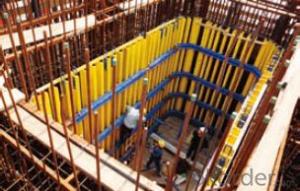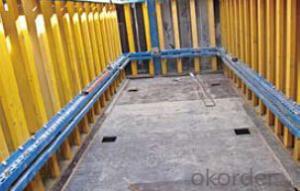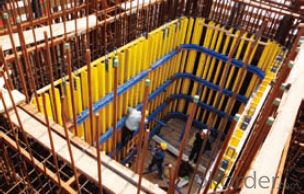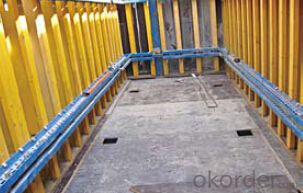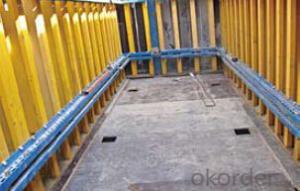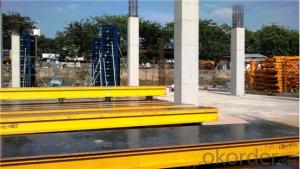Shaft-Platform System for Formwork and Scaffolding
- Loading Port:
- Tianjin
- Payment Terms:
- TT OR LC
- Min Order Qty:
- 50 m²
- Supply Capability:
- 1000 m²/month
OKorder Service Pledge
Quality Product, Order Online Tracking, Timely Delivery
OKorder Financial Service
Credit Rating, Credit Services, Credit Purchasing
You Might Also Like
Shaft Platform
As operating platform, the shaft platform is mainly used in the concrete pouring of elevator shaft,
equipment shaft, stair shaft of high-rise building and so on.
Characteristics:
◆ The length of shaft beam is adjustable.
◆ Flexible structure makes lifting easier.
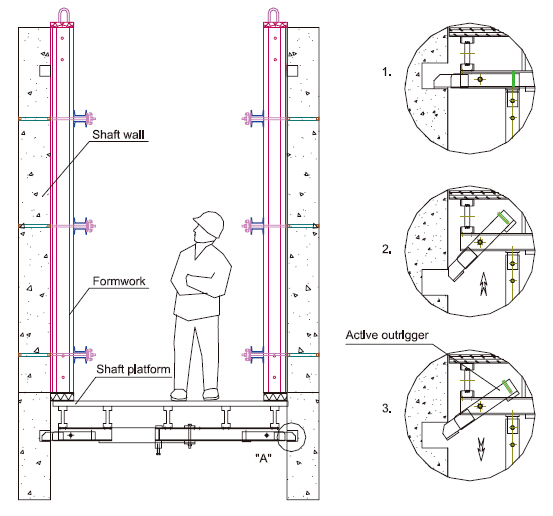
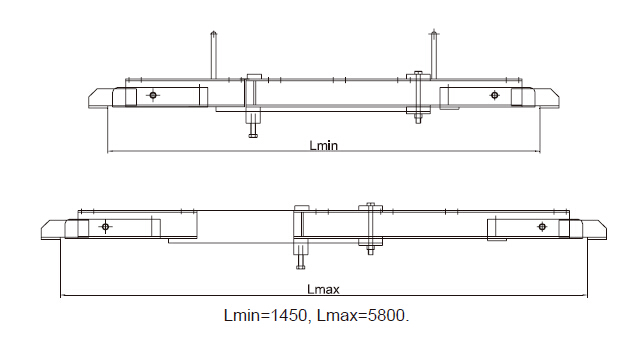
- Q: Can steel formwork be used in marine construction projects?
- Yes, steel formwork can be used in marine construction projects. Steel is a durable and strong material that can withstand the harsh conditions of marine environments, such as saltwater, waves, and corrosion. It can be used for various applications in marine construction, including the construction of docks, piers, offshore platforms, and other marine structures. The use of steel formwork ensures a stable and reliable construction process, providing long-lasting and robust structures in marine settings.
- Q: How is steel formwork disassembled?
- Steel formwork is typically disassembled using a systematic approach to ensure safe and efficient removal. The process involves several steps: 1. Inspection: Before disassembling the steel formwork, it is crucial to inspect the structure for any signs of damage or wear. This helps identify any potential hazards and allows for necessary repairs or replacements before starting the disassembly process. 2. Removal of accessories: Start by removing any accessories attached to the steel formwork, such as scaffolding, support beams, or tie rods. These accessories are often essential for the stability of the formwork system, so their removal should be done carefully and in a controlled manner. 3. Removing concrete debris: Next, remove any concrete debris or remnants that may have adhered to the steel formwork. This can be done using tools like hammers, chisels, or wire brushes. Proper cleaning of the formwork ensures smooth disassembly and prevents any future complications. 4. Dismantling panels: Begin dismantling the steel formwork panels one by one. This is typically done by removing the connecting pins, bolts, or screws that hold the panels together. The order of disassembly should follow the reverse order of the assembly process, starting from the top and working downwards. 5. Handling and storage: As each panel is disassembled, it should be carefully handled to prevent any damage or injury. Once disassembled, the panels should be properly labeled and stored in a designated area to ensure easy retrieval for future use or transportation. 6. Post-disassembly inspection: After the steel formwork has been completely disassembled, it is important to conduct a final inspection. This allows for the identification of any damaged or worn-out components that may require repairs or replacement before the next use. Overall, the disassembly process of steel formwork requires careful planning, attention to detail, and adherence to safety guidelines. Following these steps ensures the proper removal of the formwork while maintaining the integrity of the structure and ensuring the safety of workers involved.
- Q: What are the different types of connections used in steel formwork systems?
- There are several types of connections used in steel formwork systems, each serving a specific purpose. The most common types of connections are as follows: 1. Bolted Connections: This type of connection involves using bolts to join different components of the steel formwork system. Bolted connections are strong and rigid, providing stability and ensuring that the formwork remains intact during the concrete pouring process. 2. Welded Connections: Welding is another commonly used method for connecting steel formwork components. Welded connections offer excellent strength and durability, and they can withstand heavy loads and vibrations. Welding also allows for a seamless connection, reducing the risk of leakage or seepage of concrete. 3. Pin Connections: Pin connections involve using steel pins to connect different formwork components. These pins are inserted into pre-drilled holes and secured with nuts or other fasteners. Pin connections are relatively easy to assemble and disassemble, making them suitable for temporary formwork systems. 4. Clamped Connections: Clamped connections utilize clamps or couplers to connect various steel formwork elements. Clamps are typically tightened with bolts or screws to provide a secure connection. This type of connection is often used in systems where quick assembly and disassembly are required. 5. Interlocking Connections: Interlocking connections involve using interlocking mechanisms or slots to connect different formwork components. These connections are designed to fit together seamlessly, providing stability and preventing any movement or displacement during the concrete pouring process. Interlocking connections are often used in modular formwork systems. Each type of connection has its advantages and disadvantages, and the choice of connection method depends on factors such as the formwork system design, load requirements, assembly/disassembly speed, and project specifications. It is crucial to select the appropriate connection type to ensure the safety and efficiency of the steel formwork system.
- Q: How much weight can steel formwork support?
- The weight that steel formwork can support depends on various factors such as the thickness and type of steel used, the design and construction of the formwork, and the support system in place. Steel formwork is known for its high strength and durability, which enables it to support heavy loads. Generally, steel formwork can support a significant amount of weight, often ranging from several hundred kilograms to several tonnes. However, it is crucial to ensure that the formwork is properly designed, installed, and supported to safely bear the intended load. It is recommended to consult with structural engineers or follow the manufacturer's guidelines to determine the specific weight capacity of the steel formwork being used.
- Q: What are the common design considerations for steel formwork in tunnel construction?
- Some common design considerations for steel formwork in tunnel construction include the strength and stability of the formwork, the ability to withstand the pressure of the surrounding soil or rock, the ease of installation and removal, the compatibility with other construction materials and techniques, and the potential for reuse or recycling. Additionally, considerations such as cost, safety, and environmental impact may also play a role in the design process.
- Q: How does steel formwork affect the overall carbon footprint of the project?
- The overall carbon footprint of a construction project can be significantly affected by steel formwork. To begin with, the production of steel itself is a highly energy-intensive process that involves the use of fossil fuels and results in the emission of substantial amounts of greenhouse gases. The extraction and processing of raw materials like iron ore and coal also contribute to the carbon emissions associated with steel production. Furthermore, the transportation of steel formwork to the construction site adds to the carbon footprint. Due to its weight, steel requires a large amount of fuel for transportation, especially if the site is far away from the manufacturing facility. This transportation of steel formwork further contributes to the project's carbon footprint. Additionally, the lifespan and durability of steel formwork are crucial factors in its environmental impact. If the steel formwork is only used for one project and then discarded, it increases waste generation and the need for additional production and transportation of new formwork for future projects. This cycle of production and disposal further raises the carbon emissions associated with the project. Nevertheless, steel formwork does offer certain sustainability benefits that can offset its carbon footprint. Steel is a highly recyclable material, and using recycled steel in formwork production reduces the necessity for new steel production and the associated carbon emissions. Moreover, the durability of steel formwork allows for multiple uses, reducing waste generation and the carbon emissions related to disposal and replacement. To conclude, although steel formwork can contribute to a project's overall carbon footprint due to the energy-intensive production process, transportation emissions, and potential waste generation, its recyclability and durability offer opportunities to mitigate these impacts. Proper management and recycling practices can help minimize the carbon emissions associated with steel formwork and promote a more environmentally sustainable approach to construction projects.
- Q: How does steel formwork affect the overall vibration resistance of the structure?
- Steel formwork can significantly enhance the overall vibration resistance of a structure. Due to its strong and rigid nature, steel formwork provides excellent support and stability during the construction process, preventing any excessive movement or vibration. This helps in reducing the risk of structural damage or failure caused by vibration, ensuring the durability and safety of the building in the long run.
- Q: What are the limitations of using steel formwork?
- There are several limitations of using steel formwork in construction projects. Firstly, steel formwork is relatively expensive compared to other types of formwork materials such as wood or aluminum. This can significantly increase construction costs, especially for large-scale projects. Secondly, steel formwork is heavy and requires heavy machinery and equipment for transportation and installation. This can be challenging in areas with limited access or on sites with uneven terrain. Additionally, steel formwork requires skilled labor for proper installation and dismantling. This can create delays and increase labor costs if the workforce is not experienced in working with steel formwork. Moreover, steel formwork is not as flexible as other types of formwork materials. It may not be suitable for complex or irregular shapes, which can limit design possibilities. Another limitation is the potential for corrosion. Steel formwork is vulnerable to rust and corrosion, especially in environments with high moisture or chemical exposure. Regular maintenance and corrosion protection measures are essential to ensure the longevity of steel formwork. Lastly, steel formwork is not as environmentally friendly as other alternatives. Steel production involves significant energy consumption and carbon emissions, which can contribute to environmental degradation. Overall, while steel formwork offers strength and durability, its limitations in terms of cost, weight, flexibility, corrosion susceptibility, and environmental impact should be carefully considered before choosing it for construction projects.
- Q: Can steel formwork be used for complex geometric shapes?
- Yes, steel formwork can be used for complex geometric shapes. Steel is a versatile and durable material that can be easily manipulated to create intricate and unique formwork designs. Its strength allows for the construction of complex shapes without compromising structural integrity, making it suitable for various architectural and construction applications.
- Q: How does steel formwork accommodate openings and penetrations in the concrete?
- Steel formwork can accommodate openings and penetrations in the concrete by incorporating removable panels or cutouts in the formwork design. These panels can be easily removed or adjusted to create spaces for windows, doors, ducts, pipes, or any other required penetrations in the concrete structure. This flexibility allows for precise and efficient construction, ensuring that the concrete is poured accurately around the openings and penetrations, resulting in a well-structured and functional building.
Send your message to us
Shaft-Platform System for Formwork and Scaffolding
- Loading Port:
- Tianjin
- Payment Terms:
- TT OR LC
- Min Order Qty:
- 50 m²
- Supply Capability:
- 1000 m²/month
OKorder Service Pledge
Quality Product, Order Online Tracking, Timely Delivery
OKorder Financial Service
Credit Rating, Credit Services, Credit Purchasing
Similar products
Hot products
Hot Searches
Related keywords
